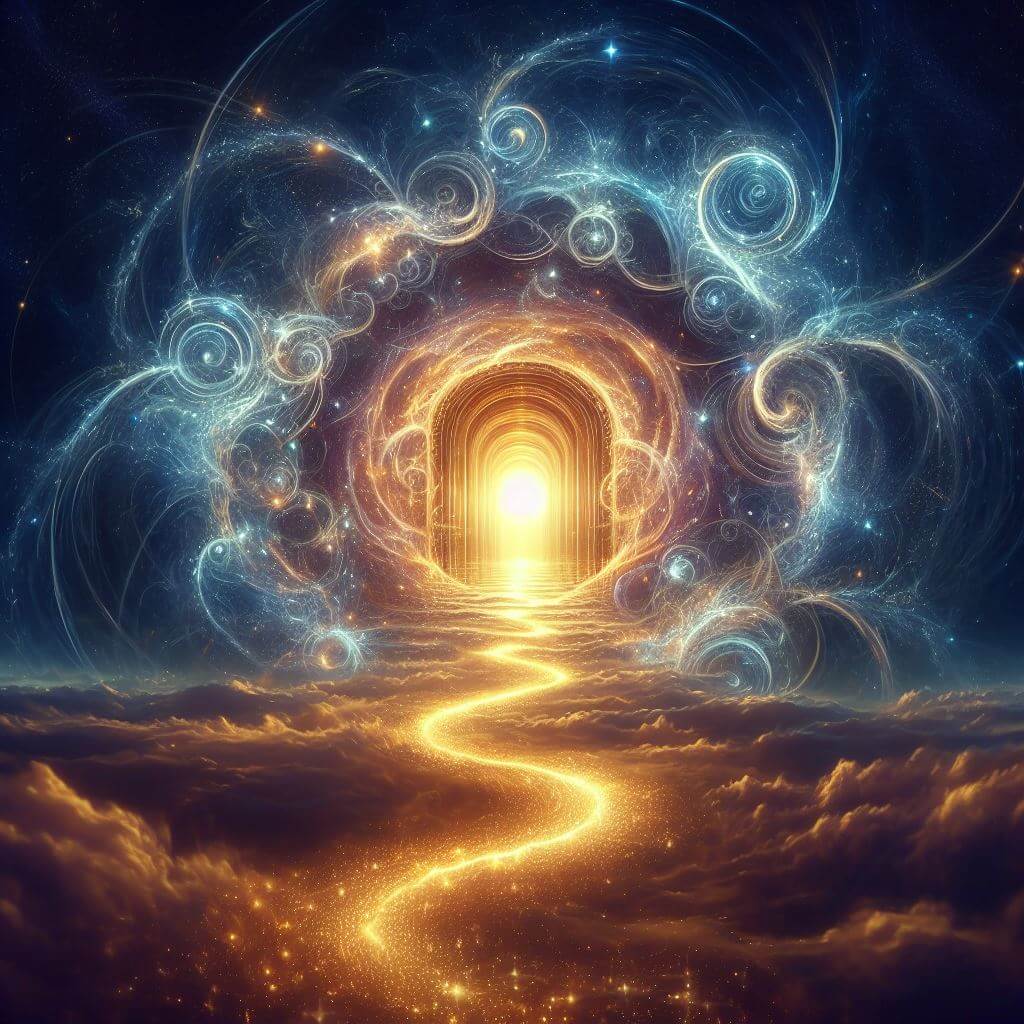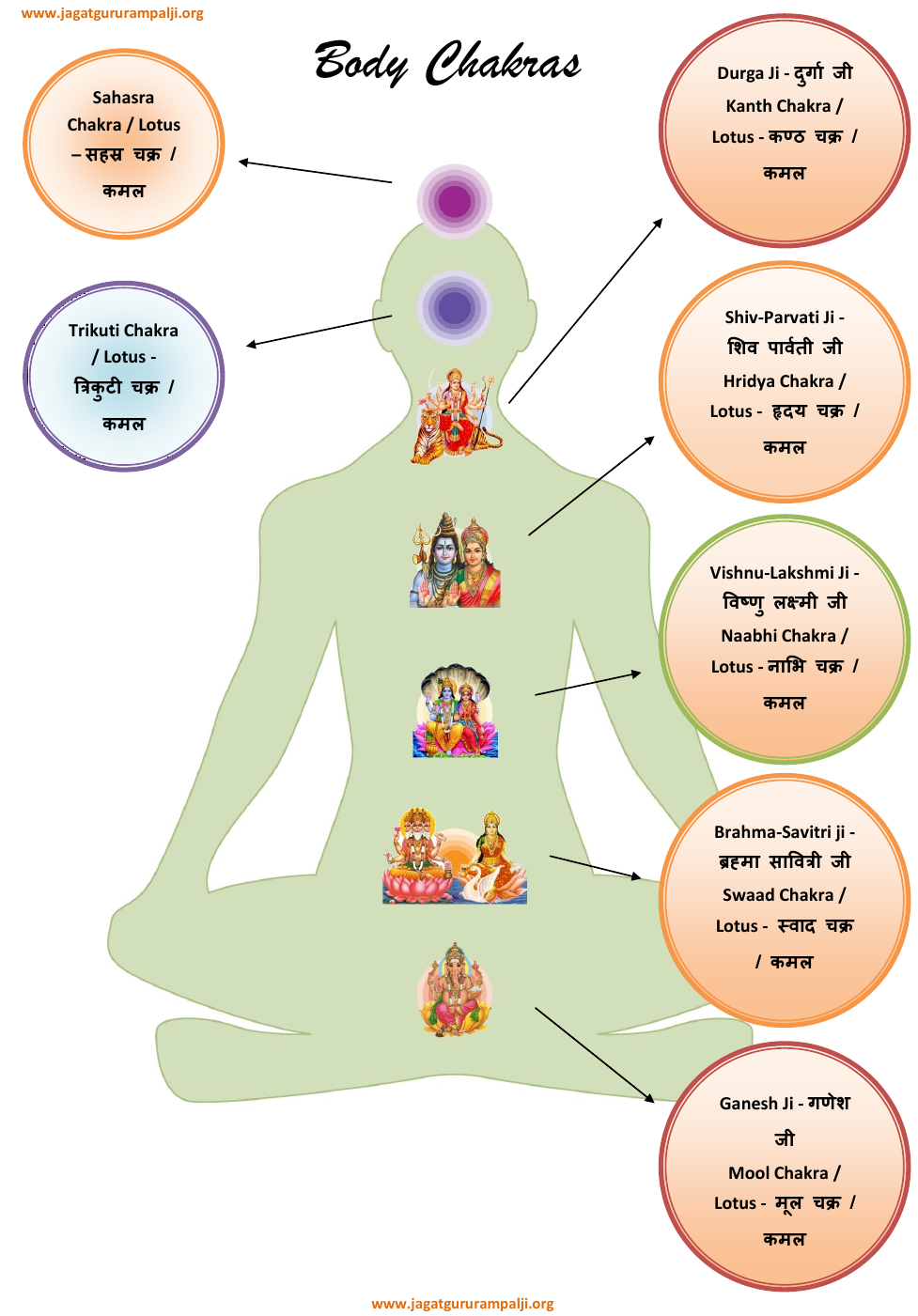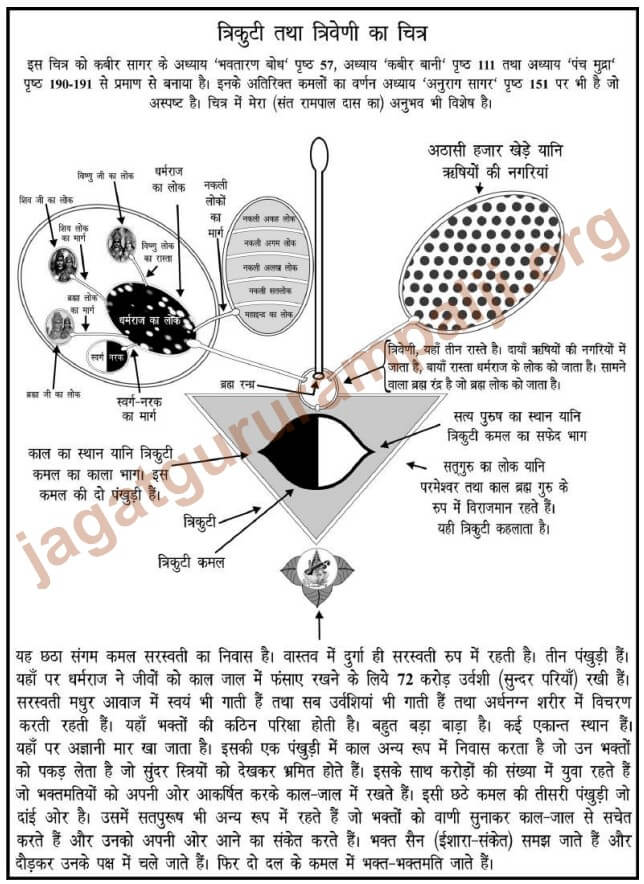Path to Satlok / Sachkhand & Body Chakras
What is Satlok

Satlok is an eternal place where there is supreme happiness and no misery. On reaching satlok, soul attains complete salvation. Readers may read here about What is Satlok. This article answers the following two questions
- What is the way to Satlok (सतलोक) / Sachkhand (सचखण्ड) / Eternal Place.
- What is the only way to achieve Salvation / Liberation / Moksh & What is the significance of Body Chakras / Lotuses.
Routemap to Satlok from Earth
Journey to satlok is a stepwise process crossing body chakras, reaching trikuti, triveni, bhanwar gufa and finally satlok. The soul passes through various stations which are as follows
- Sushumna Nadi - after death the soul enters the sushumna nadi. From there it traverses sequentially through body chakras starting with mool chakra.
- Mool Chakra
- Svadhishthana or Swad Chakra
- Nabhi Chakra
- Hridaya Chakra
- Kantha Chakra
- Trikuti Chakra - (from trikuti the soul progresses to triveni. The way to satlok is via Brahmarandhra)
- Triveni
- Brahmarandhra
- 10th Gate - Dasam Dwar (enty into Brahmlok)
- 11th Gate - enters in to Par Brahm lok (exit from Brahmlok)
- Maansarovar
- Bhanwar Gufa (passage way in Par Brahm's Lok)
- 12th Gate - this door is at the boundary of satlok. After going through the 12th gate the soul enters into Satlok
All the body chakras, triveni, Brahmarandhra, Bhanwar Gufa have been described in detail below.
Body Chakras
Every human being has got lotuses or chakras in their body whether they are male or female. There are seven chakras in the body. These extend along the length of the vertebral coloumn and lie anterior to it. These belong to different deities. Whether someone is a Hindu, Muslim, Sikh or a Christian or belongs to any other religion, the lotuses / Chakras are the same.
Detalied Information of Chakras / Kamals / Lotuses in Human Body

Important: - There are six chakras (kamal - lotuses) in the human body (material body). The backbone ends near the anus. Two-finger breadth above that is the first chakra which is called Mool Chakra —
1. Mool Kamal (Chakra) – Ganesh Ji resides in Mool Chakra. This Chakra (lotus) has four petals. Then approximately two-finger breadth above the Mool Chakra (Kamal), along the backbone, on the inner side is Swaad Chakra.
2. Swaad Kamal (Chakra) also called Svadhisthana Chakra - in Svadhisthana Chakra Brahma and Savitri reside. This chakra (lotus) has six petals.
3. Nabhi Kamal (Chakra) – Above the Swaad Chakra, in front of the umbilicus along the backbone, is Nabhi Chakra (kamal). God Vishnu and Lakshmi reside in Nabhi Chakra. It has eight petals.
4. Hridya Kamal (Chakra) – Above the Nabhi Chakra, behind the heart is a Hridya Chakra (Kamal). God Shiv and Parvati live in Hridya Chakra. This Hridya Kamal (Lotus / Chakra) has twelve petals.
5. Kanth Kamal (Chakra) – Above the Hridya Chakra is the Kanth Chakra (Kamal), which is near and behind the throat, stuck to the backbone. In Kanth Chakra, lives, Prakriti Devi (Mother Ashtangi / Durga). Kanth Chakra (Lotus) has sixteen petals.
6. Trikuti Kamal (Chakra) – Above the Kanth Kamal is Trikuti Chakra (Kamal). It has two petals (one is white and the other is of black colour). The Supreme God lives in the Trikuti Chakra. Like the sun even when situated far away keeps exerting its influence on everyone, here we have to infer it in a similar way. And the Supreme God also lives in the inner-self with the soul.
7. Sahasrar Kamal (Chakra) – Above the Trikuti Chakra, where one keeps a top-knot, in that place on the inner side is Sahansrar Chakra (Kamal) where Jyoti Niranjan (in form of light in thousand petals), Kaal (Brahm) himself lives. This Sahasrar Chakra (lotus) has one thousand petals.
Journey of a Soul through Body Chakras (Lotuses)
After death, the soul enters into the sushumna nadi and reaches the "Mool Kamal / Chakra" progressing to "Swaad Kamal / Chakra", then to "Naabhi Kamal / Chakra", then to "Hriday Kamal / Chakra", then to "Kanth Kamal / Chakra" and finally to the "Trikuti Kamal / Chakra". Please refer to the picture above.
A soul can only cross these Kamals / Chakras and reach Trikuti if these Chakras are open. These can only be opened by recitation of Mantras for these Deities. Yogis try to open these Kamals / Chakras by way of meditation which is actually a long winded and wrong way and not successful. The only way to open these Kamals / Chakras is by getting the mantras of these Deities from a "Complete Saint". A complete saint has been addressed as a Tatvadarshi Saint in Shrimad Bhagavad Gita Chapter 4 verse 34.
Journey Beyond Body Chakras
From Trikuti Kamal there is a way towards a locked door which is known as the "10th Door". The lock on this door can only be opened by the recitation of "Satnaam" (a True Mantra given by a Complete Saint). This door opens in to "Kaal's personal Lok (Universe)". This "Kaal" is also known as "Brahm". Hence Kaal's own lok is also known as "Brahm Lok". This is the limit of Kaal (Brahm) Lok. From here there is a door called the "11th Door" which opens in to the universes of "Par Brahm" (Par Brahm is the master of 700 quadrillion Brahmands / universes). This path called the "Bhanwar Gufa" finally leads to the "12th Door" which opens into Satlok / Sachkhand / Eternal Place. On crossing the 12th Door, a soul enters into the boundary of Satlok. Reaching Satlok is considered as True Moksha.
What is Bhanwar Gufa (Whirling Cave)
When the soul crosses the 11th door, it enters into the univerese of 'Par Brahm'. Par Brahm has 700 quadrillion universes. The path from the 11th door through the universes of Par Brahm until it reaches the 12th door (at the outer limit of universes of Par Brahm) is called "Bhanwar Gufa". It is a very long path as it traverses 700 quadrillion universes. At the end of this Bhanwar Gufa lies the 12th door which is the final door to cross to reach satlok. On entering into satlok, one is never born into the earth again and achieves complete salvation.
Detalied Information about Journey from Triveni to Satlok
A vivid description about journey from Trikuti, then to triveni and onwards to satlok has been given by God Kabir in his shabad Kar Naino Deedar. Sant Rampal Ji Maharaj has explained this in detail.
At triveni, there are three paths. On the left-hand side, there is a route to Dharamrai's lok. On the right-side there is a way to 88,000 (khede) places of Rishis / sages.
Graphic Representation of Trikuti and Triveni

Brahmarandhra
The central path which goes straight ahead is called the Brahmarandhra. This route goes to a lotus (kamal) with sahasrar (one-thousand) petals. It is therefore called Sahasrar Kamal. This is Kaal’s (Brahm) Mahaswarg (Great-Heaven). On reaching there one hears the sound of a bell and conch shell. Sparkling lights are also seen there.
When a worshipper moves towards Brahmarandhra, then a whole army of Yam doots (messengers of Yam, the God of death) and demonesses of terribly horrifying appearance is present there. That army of Kaal can neither be conquered by ‘Om’ naam, nor by Kiliyam’, nor by Hariyam', nor by SohM, nor by Jyoti Niranjan-Rarankar-Omkaar-SohM-Shakti (Shriyam'), nor by Radhaswami, nor by Akaal moort-Shabd Swaroopi Ram or SatPurush, or by any other arbitrary naams. They can only be countered by recitation (via breaths) of Satnaam (True Naam Mantra) granted by a true saint. That then strikes them like arrows and consequently, they run away.
How can Brahmarandhra be Opened?
Brahmarandhra can only be opened by recitation of satnaam. By recitation of Satnaam the path becomes clear as the messengers of death god run away; Brahmarandhra then opens up, and the worshipper crosses into the Brahmlok where Kaal (Brahm) is present in his actual Viraat form. Kaal blocks the 11th door with his head stuck to the opening. On recitation of satnaam Kaal’s head automtically bows down and the 11th door opens up. The worshipper then steps on the head of Kaal and enters into the 11th door and thus, it enters ParBrahm’s lok.
Sukshma Shreer (Subtle body), Kaaran and Mahakaaran and Kaivalya Shareer (subtle body covers)
There is no influence of Kaal in the universe of Par Brahm. After reaching the universe of Par Brahm recitation of Saarnaam starts automatically. Recitation of Om mantra stops because the subtle body (sukshm shareer) is left behind i.e. the earnings of ‘Om’ mantra are left with Brahm (Kaal). Kaaran and Mahakaaran also finish with the recitation of Saarnaam. At that time, only ‘Kaivalya’ shareer (body) is left. At that time, a living being’s state is similar to the brightness of 12 suns. At that point Satguru (Complete Saint) asks there, “O Hans soul! Have you got any attachment to any living being, thing, or wealth? If yes, then you will have to return to Kaal lok.” But at that time, this embodied soul has crossed the whole web of Kaal. The soul does not agree to return. Then he says, “No Satguru Ji, now I will not go to that hell.” Then, Satguru gives a bath to that hans (soul) in the nectar Maansarover (nectar lake). At that time, that hans’s (soul’s) kaivalya shareer and all other covers end, and the soul appears in aatm-tattav (self-element).
Those souls whose worship is incomplete, when they take a dip in the nectar lake (maansarovar), the brightness of their body is only equivalent to 4 suns. Those are then made to do further worship at maansarovar and they stay there until their worship is complete. Those who still have any sort of interest or attraction or desire towards planet earth are sent back to Kaal's lok. These then again fall in to the cycle of birth and death in 84 lakh life forms
Where is Maansarover situated
This Maansarover is present in the vacuum place between Par Brahm’s lok and Satlok before the Bhanwar gufa (cave) starts. At that time, the appearance of this soul becomes as effulgent as sixteen suns, and after crossing the twelfth gate and entering Satlok, the soul enjoys the bliss of Supreme God forever. This is called complete liberation / salvation.
Path to Satlok - Video
References
Categories: knowledge | Tags:
